Engage NY Eureka Math Geometry Module 2 Lesson 33 Answer Key
Eureka Math Geometry Module 2 Lesson 33 Opening Exercise Answer Key
Opening Exercise:
For each triangle shown below, identify the method (Pythagorean theorem, law of sines, law of cosines) you would use to find each length x.


Answer:
 law of sines
law of sines

Eureka Math Geometry Module 2 Lesson 33 Example Answer Key
Example 1:
Find the missing length in ∆ABC.

Answer:
→ Which method should we use to find length AB in the triangle shown below? Explain.
Provide a minute for students to discuss in pairs.
Yes. The law of sines can be used because we are given information about two of the angles and one side. We can use the triangle sum theorem to find the measure of ∠C, and then we can use that information about the value of the pair of ratios \(\frac{\sin A}{a}=\frac{\sin C}{c}\). Since the values are equivalent, we can solve to find the missing length.
→ Why can’t we use the Pythagorean theorem with this problem?
We can only use the Pythagorean theorem with right triangles. The triangle in this problem is not a right triangle.
→ Why can’t we use the law of cosines with this problem?
The law of cosines requires that we know the lengths of two sides of the triangle. We are only given information about the length of one side.
→ Write the equation that allows us to find the length of \(\overline{A B}\).
Let x represent the length of \(\overline{A B}\).
\(\frac{\sin 75}{2.93}=\frac{\sin 23}{x}\)
cx = \(\frac{2.93 \sin 23}{\sin 75}\)
→ We want to perform one calculation to determine the answer so that it is most accurate and rounding errors are avoided. In other words, we do not want to make approximations at each step. Perform the calculation, and round the length to the tenths place.
The length of \(\overline{A B}\) is approximately 1.2.
Example 2:
Find the missing length in ∆ABC.
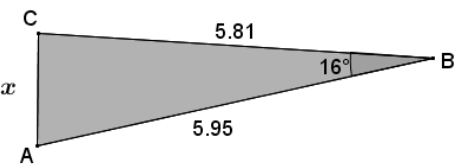
Answer:
→ Which method should we use to find side \(\overline{A C}\) in the triangle shown below? Explain.
Provide a minute for students to discuss in pairs.
We do not have enough information to use the law of sines because we do not have enough information to write any of the ratios related to the law of sines. However, we can use
b2 = a2 + c2 – 2ac cos B because we are given the lengths of sides a and c and we know the angle measure for ∠B.
→ Write the equation that can be used to find the length of \(\overline{A C}\), and determine the length using one calculation. Round your answer to the tenths place.
x2 = 5.812 + 5.952 – 2(5.81)(5.95)cos 16
x = \(\sqrt{5.81^{2}+5.95^{2}-2(5.81)(5.95) \cos 16}\)
x ≈ 1.6
Eureka Math Geometry Module 2 Lesson 33 Exercise Answer Key
Exercises 1 – 6:
Use the laws of sines and cosines to find all missing side lengths for each of the triangles in the exercises below. Round your answers to the tenths place.
Exercise 1.
Use the triangle to the right to complete this exercise.
a. Identify the method (Pythagorean theorem, law of sines, law of cosines) you would use to find each of the missing lengths of the triangle. Explain why the other methods cannot be used.
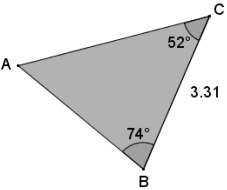
Answer:
Law of sines
The Pythagorean theorem requires a right angle, which is not applicable to this problem. The law of cosines requires information about two side lengths, which is not given. Applying the law of sines requires knowing the measure of two angles and the length of one side.
b. Find the lengths of \(\overline{A C}\) and \(\overline{A B}\).
Answer:
By the triangle sum theorem, m∠A = 54°
Let b represent the length of side \(\overline{A C}\).
\(\frac{\sin 54}{3.31}=\frac{\sin 74}{b}\)
b = \(\frac{3.31 \sin 74}{\sin 54}\)
b ≈ 3.9
Let C represent the length of side \(\overline{A B}\)
\(\frac{\sin 54}{3.31}=\frac{\sin 52}{c}\)
c = \(\frac{3.31 \sin 52}{\sin 54}\)
c ≈ 3.2
Exercise 2.
Your school is challenging classes to compete in a triathlon. The race begins with a swim along the shore and then continues with a bike ride for 4 miles. School officials want the race to end at the place it began, so after the 4-mile bike ride, racers must turn 30° and run 3.5 miles directly back to the starting point. What is the total length of the race? Round your answer to the tenths place.

a. Identify the method (Pythagorean theorem, law of sines, law of cosines) you would use to find the total length of the race. Explain why the other methods cannot be used.
Answer:
Law of cosines
The Pythagorean theorem requires a right angle, which is not applicable to this problem because we do not know if we have a right triangle. The law of sines requires information about two angle measures, which is not given. Applying the law of cosines requires knowing the measure of two sides and the included angle measure.
b. Determine the total length of the race. Round your answer to the tenths place.
Answer:
Let a represent the length of the swim portion of the tri at halon.
a2 = 42 + 3.52 – 2(4)(3.5)cos30
a = \(\sqrt{4^{2}+3.5^{2}-2(4)(3.5) \cos 30}\)
a = 2.000322148 …
a ≈ 2
Total length of the race: 4 + 3.5 + (2) ≈ 9.5
The total length of the race is approximately 9.5 miles.
Exercise 3.
Two lighthouses are 30 miles apart on each side of shorelines running north and south, as shown. Each lighthouse keeper spots a boat in the distance. One lighthouse keeper notes the location of the boat as 40° east of south, and the other lighthouse keeper marks the boat as 32° west of south. What is the distance from the boat to each of the lighthouses at the time it was spotted? Round your answers to the nearest mile.
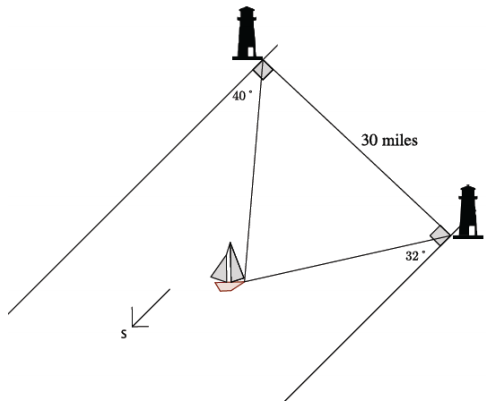
Answer:
Let x be the distance from the southern lighthouse to the boat.
\(\frac{\sin 72}{30}=\frac{\sin 50}{x}\)
x = \(\frac{30 \sin 50}{\sin 72}\)
x = 24.16400382…
The southern lighthouse is approximately 24 mi. from the boat.
Let y be the distance from the northern lighthouse to the boat.
\(\frac{\sin 72}{30}=\frac{\sin 50}{x}\)
y = \(\frac{30 \sin 58}{\sin 72}\)
y = 26.750716 12…
The northern lighthouse is approximately 27 mi.from the boat.
Let a be the distance from the northern lighthouse to the boat.
a2 = 302 + 242 – 2(30)(24) . cos58
a = \(\sqrt{30^{2}+24^{2}-2(30)(24) \cdot \cos 58}\)
a = 26.700491 75…
The northern lighthouse is approximately 27 mi. from the boat.
Exercise 4.
A pendulum 18 in. in length swings 72° from right to left. What is the difference between the highest and lowest point of the pendulum? Round your answer to the hundredths place, and explain how you found it.

Answer:

At the bottom of a swing, the pendulum is perpendicular to the ground, and it bisects the 72° angle; therefore, the pendulum currently forms an angle of 36° with the vertical. By the triangle sum theorem, the angle formed by the pendulum and the horizontal is 54°. The sin 54 will give us the length from the top of the pendulum to where the horizontal and vertical lines intersect, x, which happens to be the highest point of the pendulum.
sin 54 = \(\frac{x}{18}\)
18 sin 54 = x
14.5623059… = x
The lowest point would be when the pendulum is perpendicular to the ground, which would be exactly 18 in. Then, the difference between those two points is approximately 3.44 in.
Exercise 5.
What appears to be the minimum amount of information about a triangle that must be given in order to use the law of sines to find an unknown length?
Answer:
To use the law of sines, you must know the measures of two angles and at least the length of one side.
Exercise 6.
What appears to be the minimum amount of information about a triangle that must be given in order to use the law of cosines to find an unknown length?
Answer:
To use the law of cosines, you must know at least the lengths of two sides and the angle measure of the included angle.
Eureka Math Geometry Module 2 Lesson 33 Problem Set Answer Key
Question 1.
Given triangle EFG, FG = 15, angIe E has a measure of 38°, and angle F has a measure of 72°, find the measures of the remaining sides and angle to the nearest tenth. Justify your method.

Answer:
Using the angle sum of a triangle, the remaining angle G has a measure of 70°. The given triangle provides two angles and one side opposite a given angle, so it is appropriate to apply the law of sines.
\(\frac{\sin 38}{15}=\frac{\sin 72}{E G}=\frac{\sin 70}{E F}\)
\(\frac{\sin 38}{15}=\frac{\sin 70}{E F}\)
EF = \(\frac{15 \sin 70}{\sin 38}\)
EF ≈ 22.9
\(\frac{\sin 38}{15}=\frac{\sin 72}{E G}\)
EG = \(\frac{15 \sin 72}{\sin 38}\)
EG ≈ 23.2
Question 2.
Given triangle ABC, angle A has a measure of 75°, AC = 15.2, and AB = 24, find BC to the nearest tenth. Justify your method.

Answer:
The given information provides the lengths of the sides of the triangle and an included angle, so it is appropriate to use the law of cosines.
BC2 = 242 + 15.22 – 2(24)(15.2)(cos 75)
BC2 = 576 + 231.04 – 729.6 cos 75
BC2 = 807.04 – 729.6 cos 75
BC = \(\sqrt{807.04-729.6 \cos 75}\)
BC ≈ 24.9
Question 3.
James flies his plane from point A at a bearing of 32° east of north, averaging a speed of 143 miles per hour for 3 hours, to get to an airfield at point B. He next flies 69° west of north at an average speed of 129 miles per hour for 4.5 hours to a different airfield at point C.

a. Find the distance from A to B.
Answer:
distance = rate . time
d = 143 . 3
d = 429
The distance from A to B is 429 mi.
b. Find the distance from B to C.
Answer:
distance = rate . time
d = 129 . 4.5
d = 580.5
The distance from B to C is 580.5 mi.
c. Find the measure of angle ABC.
Answer:
All lines pointing to the north/south are parallel; therefore, by alternate interior ∠’s, the return path from B to A is 32° west of south. Using angles on a line, this mentioned angle, the measure of the angle formed by the path from B to C with north (69°) and m∠ABC sum to 180; thus, m∠ABC = 79°.
d. Find the distance from C to A.
Answer:

The triangle shown provides two sides and the included angle, so using the law of cosines,
b2 = a2 + c2 – 2ac(cos B)
b2 = (580.5)2 + (429)2 – 2(580.5)(429)(cos 79)
b2 = 336980.25 + 184041 – 498069(cos 79)
b2 = 521021.25 – 498069(cos 79)
b = \(\sqrt{521021.25-498069(\cos 79)}\)
b ≈ 652.7
The distance from C to A is approximately 652.7 mi.
e. What length of time can James expect the return trip from C to A to take?
Answer:
distance = rate . time
652.7 = 129 t1
5.1 ≈ t1
distance = rate . time
652.7 = 143t2
4.6 ≈ t2
James can expect the trip from C to A to take between 4.6 and 5. 1 hours.
Question 4.
Mark is deciding on the best way to get from point A to point B as shown on the map of Crooked Creek to go fishing. He sees that if he stays on the north side of the creek, he would have to walk around a triangular piece of private property (bounded by \(\overline{A C}\) and \(\overline{B C}\)).
His other option is to cross the creek at A and take a straight path to B, which he knows to be a distance of 1.2 mi. The second option requires crossing the water, which is too deep for his boots and very cold. Find the difference in distances to help Mark decide which path is his better choice.

Answer:
\(\overline{A B}\) is 4.82° north of east, and \(\overline{A C}\) is 24.39° east of north. The directions north and east are perpendicular, so the angles at point A form a right angle. Therefore, m∠CAB = 60.79°.
By the angle sum of a triangle, m∠PCA = 103.68°.
∠PCA and ∠BCA are angles on a line with a sum of 180°, s0 m∠BCA = 76.32°.
Also, by the angle sum of a triangle,
m∠ABC = 42.89°.
Using the law of sines:
\(\frac{\sin A}{a}=\frac{\sin B}{b}=\frac{\sin C}{c}\)
\(\frac{\sin 60.79}{a}=\frac{\sin 42.89}{b}=\frac{\sin 76.32}{1.2}\)
b ≈ 0.8406
a ≈ 1.0780
Let d represent the distance from point A to B through point C in miles.
d = AC + BC
d ≈ 0.8406 + 1.0780
d ≈ 1.9
The distance from point A to B through point C is approximately 1.9 mi. This distance is approximately 0.7 mi. longer than walking a straight line from A to B.
Question 5.
If you are given triangle ABC and the measures of two of its angles and two of its sides, would it be appropriate to apply the law of sines or the law of cosines to find the remaining side? Explain.
Answer:
Case 1:
Given two angles and two sides, one of the angles being an included angle, it is appropriate to use either the law of sines or the law of cosines.
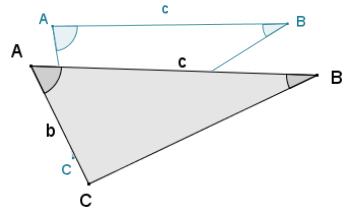
Case 2:
Given two angles and the sides opposite those angles, the law of sines can be applied as the remaining anglecan be calculated using the angle sum of a triangle. The law of cosines then can also be applied as the previous calculation provides an included angle.

Eureka Math Geometry Module 2 Lesson 33 Exit Ticket Answer Key
Question 1.
Given triangle MLK, KL = 8, KM = 7, and m∠K = 75°, find the length of the unknown side to the nearest tenth.
Justify your method.
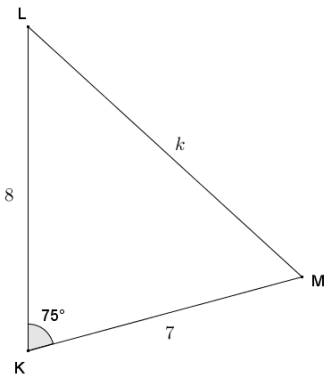
Answer:
The triangle provides the lengths of two sides and their included angles,
so using the law of cosines:
k2 = 82 + 72 – 2(8)(7)(cos 75)
k2 = 64 + 49 – 112(cos 75)
k2 = 113 – 112(cos 75)
k = \(\sqrt{113-112(\cos 75)}\)
k ≈ 9.2
Question 2.
Given triangle ABC, m∠A = 36°, ∠B = 79°, and AC = 9, find the lengths of the unknown sides to the nearest tenth.

Answer:
By the angle sum of a triangle, m∠C = 65°.
Using the law of sines:
\(\frac{\sin A}{a}=\frac{\sin B}{b}=\frac{\sin C}{c}\)
\(\frac{\sin 36}{a}=\frac{\sin 79}{9}=\frac{\sin 65}{c}\)
a = \(\frac{9 \sin 36}{\sin 79}\)
a ≈ 5.4
c = \(\frac{9 \sin 65}{\sin 79}\)
c ≈ 8.3
AB ≈ 8.3 and BC ≈ 5.4